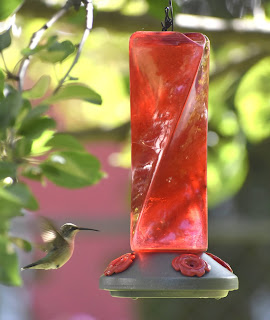The book Honey for a Child's Heart by Gladys Hunt has been on my list of books to read ever since I started homeschooling Sophia and Olivia.
It's an insightful book about the power of books and literature on a child's life. Much of what is shared is consistent with how I raised and educated the girls, so the book is an affirmation of how I chose to teach them.
Some highlights from the book include:
- Few things are more important for a child than to discover the joy of reading. Give him a love of reading, and you have given him not only the most satisfying and useful of all recreations but also the key to true learning.
- It introduces us to people and places we wouldn't ordinarily know. A good book is a magic gateway into a wider world of wonder, of beauty, of delight and adventure. Books are experiences that make us grow, that add something to our inner stature.
- Children don't stumble onto good books by themselves; they must be introduced to the wonder of words put together in such a way that they spin out pure joy and magic.
- Somehow a limited, poverty-stricken vocabulary works toward equally limited use of ideas and imagination.
- "Snow is the most beautiful silence in the world." (Dobry, by Monica Shannon)
- I have never been able to resist the appeal of a child who asks, "Read to me, please?" The warm security of a little person cuddled close, loving the pictures which help tell the story, listening to the rhythm of the words, laughing in all the right places as the policeman stops Boston traffic for the mother duck and her family in Robert McCloskey's Make Way for Ducklings.
- But the pleasure doesn't end with small children who like to sit on your lap. Growing-up children are just as much fun. Reading Laura Ingalls Wilder's books of pioneer adventure on the prairie, our family could feel the warm cabin, smell the freshly baked bread, hear the blizzard raging outside, and experience with Laura the close family feeling of Pa's singing and fiddling by the fireside.
- Books do impart a sense of security. Children meet others whose backgrounds, religions and cultural ways are unlike their own.
- Geography invades our living rooms as children visit families from other countries, and the world seems quite friendly.
- We are concerned about building whole people - people who are alive emotionally, spiritually, intellectually.
- A young child, a fresh uncluttered mind, a world before him - to what treasures will you lead him? With what will you furnish his spirit?
- Parents unconsciously teach their children what is valuable by the way they spend their own time.
- Families do have to repeatedly make conscious decisions about what is valuable and then choose the best over the mediocre.
- Erich Fromm in his book The Art of Loving speaks of a child's basic need for milk and honey from his parents. Milk is the symbol of the care a child receives for his physical needs, for his person. Honey symbolizes the sweetness of life, that special quality that gives the sparkle within a person...To give honey, one must love honey and have it to give. Good books are rich in honey.
- A busy schedule is the enemy of reading.
- Exposing him to a variety in art helps him to choose what he likes.
- Good books are written not so much for children as written by people who have not lost their childhood.
- C.S. Lewis says that no book is really worth reading at the age of ten which is not equally worth reading at the age of fifty.
- Real books have life. They release something creative in the minds of those who absorb them.
- A good writer has something worthy to say and says it in the best possible way.
Some books that we haven't read that would be worth reading:
- The Adventures of Sherlock Holmes
- Adventures of Richard Hannay
- Mary Poppins (written by Pamela Travers)
- The Day We Saw the Sun Come Up (Alice Goudey). Also the author's books on nature for older children
- May I Bring a Friend? (Beatrice S. de Regniers)
- A Pocketful of Cricket (Rebecca Caudhill)
- Five Chinese Brothers (Claire H. Bishop)
- Sam, Bangs, and Moonshine (Evaline Ness)
- Moy Moy (Leo Politi)
- Melindy's Medal (G. Faulkner)
- The Moffats (Eleanor Estes)
- The Empty Schoolhouse (Natalie S. Carlson)
- My Borther Stevie (Eleanor Clymer)
- Silver Chief: Dog of the North (John O'Brien)
- Lassie Come Home (Eric Knight)
- My Side of the Mountain (Jean George)
- Freedom Train (Dorothy Sterling)
- Alice's Adventures in Wonderland (Lewis Carroll)
- Swallows and Amazons (Arthur Ransome)
- Onion John (Joseph Krumgold)
- North to Freedom (Anne Holm)
- The Wishing Tree (William Faulkner)
- The Adventures of Tom Sawyer
- The Adventures of Huckkleberry Finn
- The Prince and the Pauper
- Shadow in the Pines (Stephen Meader)
- Winter Danger (William O. Steele)
- Moby Dick )Herman Melville)
- Adventures of Sherlock Holmes (Sir Arthur Conan Doyle)
- Hound of Baskervilles
- Suki and the Invisible Peacock
- Suki and the Old Umbrella (Joyce Blackburn)
- Little Pilgrim's Progress (Helen L. Taylor)
- The Chronicles of Narnia (C.S. Lewis)
- Jungle Doctor Series (Paul White)


















